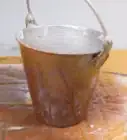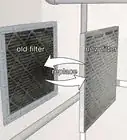This article was co-authored by Veronica Winters. Veronica Winters is a Figurative Artist who owns an online art gallery and studio in Naples, Florida. With over 20 years of experience, Veronica specializes in surreal figurative oil paintings and colored pencil drawings. In 2022, she won the Award for Distinction at the 30th Annual Colored Pencil Society of America International Exhibition. Veronica is also a published author of two art books: How to Color Like an Artist and The Colored Pencil Manual. She received her BFA in Studio Art at Oklahoma State University and her MFA in Painting at Pennsylvania State University. Veronica also studied classical drawing at the Grand Central Academy of Art and the Art Students League of New York.
There are 10 references cited in this article, which can be found at the bottom of the page.
This article has been viewed 31,142 times.
Painting aluminum foil is a fun activity to do with kids of all ages as well as adults, since the paint glides onto the foil smoothly and dries quickly. To paint foil you'll need craft paint in your desired colors, foil, brushes or cotton swabs, and dish soap to add to the paint. With a little bit of time and some creativity, you'll have a beautifully painted piece of foil!
Steps
Painting on Aluminum Foil
-
1Rip off a piece of aluminum foil that’s at least 1 foot (0.30 m) wide. The piece of foil needs to be large enough to cover your work surface or the size that you’d like the painting to be. Use a built-in foil cutter that's attached to your box of aluminum foil or scissors to prepare a piece of foil without folding or bending it.[1]
- Tin foil is a little stiffer than aluminum foil but can also be used the same way.
-
2Spread the foil out on a flat surface, securing it to the table if desired. Place the foil on a clean, flat surface like a kitchen counter or clear tabletop. If you’re worried about the foil moving around while it’s being painted, use painter’s tape to secure it to the table.[2]
- If there are any crumbs or small pieces of dirt on the table, it will cause indentations in the foil.
- Put painter’s tape on the back of the foil to keep it in place, or place it along the edges.
Advertisement -
3Pour your paint colors onto a palette or paper plate. Decide which colors you’d like to paint with and pour them onto a paint palette or paper plate so that they're not touching. Tempera or acrylic paint is best, though any type of craft paint will work.[3]
- Place a large paper towel or regular towel under the paint to prevent it from getting on the table.
- Purchase the paint from your local craft or big box store.
- Use bright colors that will show up on the foil like red, blue, or purple.
-
4Add dish soap to each paint color to help the paint stick to the foil. To help regular paint go onto the foil smoothly and stay in place, add a small squirt of dish soap to each color that you’re using. Mix it together thoroughly using a popsicle stick or small spoon to ensure the dish soap and paint are well combined.[4]
- There’s no exact amount of dish soap to use–just add a drop or two before mixing it together, creating a ratio of roughly 1:6 of dish soap to paint.
-
5Use a paintbrush or cotton swabs to paint the foil. Cotton swabs work well to paint with as they glide across the piece of foil very smoothly. Regular paint brushes in small or large sizes work as well. Dip the cotton swab or paintbrush into the desired color of paint and brush it onto the foil, just as if you were painting regular paper.[5]
- Foil is super thin by nature, it's easy to scratch it during the application process. Therefore use a super soft and clean brush to paint.
- Finger painting on the foil is also a fun option.
-
6Switch colors by rinsing your brush or using a new cotton swab. Keep a cup of water next to the palette of paint so you can rinse out your paintbrush when needed. If you’re using cotton swabs, use a new cotton swab for each color so that they don’t blend together and create a brown color.[6]
- Continue using different colors until the foil painting is finished.
-
7Create a print of your painting using a piece of paper, if desired. If you’d like to transfer the foil painting onto a piece of construction paper or regular printer paper, place the piece of paper down on the painted foil. Use your hands to press down on the paper gently, smoothing the entire surface with your fingers so the paint is transferred to the piece of paper. Lift up the paper carefully to avoid smudges.[7]
- Make the print while the paint is still super wet, otherwise it won’t work.
- Be aware that the painting transferred on the paper will come out backwards.
- Let the paint dry before hanging or displaying it.
Using Foil to Paint Textures
-
1Rip off a piece of foil that’s roughly 6–12 inches (15–30 cm) wide. The length of your piece of foil doesn’t matter too much and doesn’t need to be precise. If you want smaller foil balls to use while painting, use a piece of foil that’s about 6 inches (15 cm) long. The more foil you rip off, the larger your scrunched up foil ball will be.[8]
- Consider ripping off several different sizes of foil to see which one works best for your project.
-
2Scrunch the foil up into a loose ball. Take your piece of foil in your hands and gently scrunch it up. The texture created by scrunching up the foil will be used as a stamp, creating a textured marking on the paper using the paint.[9]
- For a tighter, more detailed texture, scrunch the foil up more tightly. A loose foil ball will create a looser, more spread out texture.
-
3Create a foil ball for each paint color you’d like to use. Choose how many colors of paint you’d like to use for your painting and make enough foil balls for each separate color. This will ensure that the colors don’t blend together on the foil balls and create a muddled painting.[10]
- Add your paint colors to a paper plate or paint palette, leaving enough space between each one so that the foil balls can be rolled around in each color.
-
4Dip a scrunched-up foil ball in a paint color. Dab the foil ball in the desired color of paint, moving it around in circles to get the paint into the deeper creases of the foil. Since you’re using the foil ball as a stamp, there’s no need to cover all the sides of the ball.[11]
-
5Dab the paint onto your paper using the foil ball to create textures. Once there’s paint on the foil ball, start applying it to your picture. You might use the foil ball to create the appearance of leaves on a tree using green paint, or you could create snow using white paint. Dab carefully without rubbing the foil ball around on the page so you don’t smear the paint.[12]
- Dip the foil ball back into the paint whenever it starts to run out.
- Dab the paint onto a spare piece of paper to see what the texture will look like before putting it on your painting.
-
6Use the other foil balls to apply other colors, layering as desired. Instead of using one foil ball to apply all the different colors of paint, use a separate foil ball for each color. Continue switching between colors, applying additional layers of paint on the picture as desired.[13]
- Dab carefully to ensure the colors don't blend together too much.
- Let the paint dry completely before displaying the picture.
Things You'll Need
Painting on Aluminum Foil
- Aluminum foil
- Scissors (optional)
- Painter's tape (optional)
- Craft paint in desired colors
- Paper towels
- Dish soap
- Paint brush or cotton swabs
- Cup of water
- Paper (optional)
Using Foil to Paint Textures
- Aluminum foil
- Craft paint in desired colors
- Paper
References
- ↑ https://www.youtube.com/watch?v=2g0-JOSbM1c#t=2s
- ↑ http://www.haringkids.com/lesson_plans/learn/painting-on-aluminum-foil
- ↑ http://www.haringkids.com/lesson_plans/learn/painting-on-aluminum-foil
- ↑ http://www.haringkids.com/lesson_plans/learn/painting-on-aluminum-foil
- ↑ https://www.youtube.com/watch?v=2g0-JOSbM1c#t=12s
- ↑ https://www.youtube.com/watch?v=2g0-JOSbM1c#t=17s
- ↑ https://www.youtube.com/watch?v=2g0-JOSbM1c#t=34s
- ↑ https://www.youtube.com/watch?v=o4o8lmirIoA#t=9s
- ↑ https://www.farmwifecrafts.com/tree-foil-painting/





















































